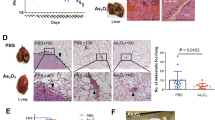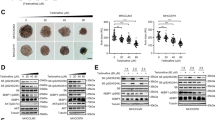Abstract
A major concern in clinical treatment of cancers is resistance of tumors such as hepatocellular carcinoma (HCC) and osteosarcoma to current chemotherapy protocols. Here, we reported that overexpression of second mitochondria-derived activator of caspase (Smac) sensitized osteosarcoma cells and HCC cells in vitro to chemotherapeutic drugs-induced apoptosis. Constitutive expression of Smac resulted in enhanced Bax accumulation on mitochondria upon etoposide stimulation and inhibited Bcl-2-induced antiapoptosis activity. Thus, Smac would sensitize tumor cells to chemotherapeutic drugs in part through promoting Bax translocation to mitochondria and bypassing Bcl-2 block. Moreover, we demonstrated that blockade of Smac expression by antisense smac did not impair etoposide-induced apoptosis; however, p53-induced apoptosis was impaired in smac deficient Saos-2 cell. This suggested Smac might be required in p53-induced apoptosis. Most importantly, complete eradication of HepG2 xenografts in vivo was achieved upon combined therapy with Ad-Smac and 5-Fu. Thus, overexpression of Smac in tumor cells might be a potent strategy for cancer treatment by sensitization of tumor cells to chemotherapeutic drugs.
This is a preview of subscription content, access via your institution
Access options
Subscribe to this journal
Receive 12 print issues and online access
$259.00 per year
only $21.58 per issue
Buy this article
- Purchase on Springer Link
- Instant access to full article PDF
Prices may be subject to local taxes which are calculated during checkout







Similar content being viewed by others
References
Johnstone RW, Ruefli AA, Lowe SW . Apoptosis: a link between cancer genetics and chemotherapy. Cell 2002; 108: 153–164.
Igney FH, Krammer PH . Death and anti-death: tumor resistance to apoptosis. Nat Rev Cancer 2002; 2: 277–288.
Reed JC . Apoptosis-based therapies. Nat Rev Drug Discov 2002; 1: 111–121.
Hengartner MO . The biochemistry of apoptosis. Nature 2000; 407: 770–775.
Liu X, Kim CN, Yang J, Jemmerson R, Wang X . Induction of apoptotic program in cell-free extracts: requirement for dATP and cytochrome c. Cell 1996; 86: 147–157.
Du C, Fang M, Li Y, Li L, Wang X . Smac, a mitochondrial protein that promotes cytochrome c-dependent caspase activation by eliminating IAP inhibition. Cell 2000; 102: 33–42.
Verhagen AM, Ekert PG, Pakusch M, Silke J, Connolly LM, Reid GE et al. Identification of DIABLO, a mammalian protein that promotes apoptosis by binding to and antagonizing IAP proteins. Cell 2000; 102: 43–53.
Deveraux QL, Reed JC . IAP family proteins-suppressors of apoptosis. Gene Dev 1999; 13: 239–252.
Srinivasula SM, Hegde R, Saleh A, Datta P, Shiozaki E, Chai J et al. A conserved XIAP-interaction motif in caspase-9 and Smac/DIABLO regulates caspase activity and apoptosis. Nature 2001; 410: 112–116.
He TC, Zhou S, da Costa LT, Yu J, Kinzler KW, Vogelstein B . A simplified system for generating recombinant adenoviruses. Proc Natl Acad Sci USA 1998; 95: 2509–2514.
Yang J, Liu X, Bhalla K, Kim CN, Ibrado AM, Cai J et al. Prevention of apoptosis by Bcl-2: release of cytochrome c from mitochondria blocked. Science 1997; 275: 1129–1132.
Adrain C, Creagh EM, Martin SJ . Apoptosis-associated release of Smac/DIABLO from mitochondria requires active caspases and is blocked by Bcl-2. EMBO J 2001; 20: 6627–6636.
Deng Y, Lin Y, Wu X . TRAIL-induced apoptosis requires Bax-dependent mitochondrial release of Smac/DIABLO. Gene Dev 2002; 16: 33–45.
Vogelstein B, Lane D, Levine AJ . Surfing the p53 network. Nature 2000; 408: 307–310.
Vousden KH, Lu X . Live or let die: the cell's response to p53. Nature Rev Cancer 2002; 2: 594–604.
Wei MC, Zong W, Cheng EH, Lindsten T, Panoutsakopoulou V, Ross AJ et al. Proapoptotic BAX and BAK: a requisite gateway to mitochondrial dysfunction and death. Science 2001; 292: 727–730.
Hsu YT, Wolter KG, Youle RJ . Cytosol-to-membrane redistribution of Bax and Bcl-XL during apoptosis. Proc Natl Acad Sci USA 1997; 94: 3668–3672.
Wolter KG, Hsu YT, Smith CL, Nechushtan A, Xi XG, Youle RJ . Movement of Bax from the cytosol to mitochondria during apoptosis. J Cell Biol 1997; 139: 1281–1292.
Cory S, Adams JM . The bcl2 family: regulators of the cellular life-or-death switch. Nat Rev Cancer 2002; 2: 647–655.
Kirkin V, Joos S, Zornig M . The role of Bcl-2 family members in tumorigenesis. Biochim Biophys Acta 2004; 1644: 229–249.
Takehara T, Liu X, Fujimoto J, Friedman SL, Takahashi H . Expression and role of Bcl-xL in human hepatocellular carcinomas. Hepatology 2001; 34: 55–61.
Watanabe J, Kushihata F, Honda K, Mominoki K, Matsuda S, Kobayashi N . Bcl-xL overexpression in human hepatocellular carcinoma. Int J Oncol 2002; 21: 515–519.
Burden DA, Osheroff N . Mechanism of action of eukaryotic topoisomerase II and drugs targeted to the enzyme. Biochim Biophys Acta 1998; 1400: 139–154.
Karpinich NO, Tafani M, Rothman RJ, Russo MA, Farber JL . The course of etoposide-induced apoptosis from damage to DNA and p53 activation to mitochondrial release of cytochrome c. J Biol Chem 2002; 277: 16547–16552.
Li P, Dietz R, Harsdorf R . p53 regulates mitochondrial membrane potential through reactive oxygen species and induces cytochrome c-independent apoptosis blocked by Bcl-2. EMBO J 1999; 18: 6027–6036.
Schuler M, Bossy-Wetzel E, Goldstein JC, Fitzgerald P, Green DR . p53 induces apoptosis by caspase activation through mitochondrial cytochrome c release. J Biol Chem 2000; 275: 7337–7342.
Okada H, Suh WK, Jin J, Woo M, Du C, Elia A et al. Generation and characterization of Smac/DIABLO-deficient mice. Mol Cell Biol 2002; 22: 3509–3517.
Antonsson B, Montessuit S, Sanchez B, Martinou JC . Bax is present as a high molecular weight oligomer/complex in the mitochondrial membrane of apoptotic cells. J Biol Chem 2001; 276: 11615–11623.
Mikhailov V, Mikhailova M, Pulkrabek DJ, Dong Z, Venkatachalam MA, Saikumar P . Bcl-2 prevents Bax oligomerization in the mitochondrial outer membrane. J Biol Chem 2001; 276: 18361–18374.
Goping IS, Gross A, Lavoie JN, Nguyen M, Jemmerson R, Roth K et al. Regulated targeting of BAX to mitochondria. J Cell Biol 1998; 143: 207–215.
Nechushtan A, Smith CL, Hsu YT, Youle RJ . Conformation of the Bax C-terminus regulates subcellular location and cell death. EMBO J 1999; 18: 2330–2341.
Finucane DM, Bossy-Wetzel E, Waterhouse NJ, Cotter TG, Green DR . Bax-induced caspase activation and apoptosis via cytochrome c release from mitochondria is inhibitable by Bcl-xL. J Biol Chem 1999; 274: 2225–2233.
Nutt LK, Chandra J, Pataer A, Fang B, Roth JA, Swisher SG et al. Bax-mediated Ca2+ mobilization promotes cytochrome c release during apoptosis. J Biol Chem 2002; 277: 20301–20308.
Acknowledgements
We thank Dr Xiaodong Wang for providing antibody to Smac and plasmid encoding smac cDNA and Ms Yan Huang and Ms Xiaodong Li for their assistance with the experiments. This work is supported in part by grants from National Natural Science Foundation of China, Ministry of Science and Technology of China (973 program) and Shanghai Commission of Science and Technology. Dr Jian Zhao is an excellent investigator supported by a fellowship award from Ministry of Education of China.
Author information
Authors and Affiliations
Corresponding author
Rights and permissions
About this article
Cite this article
Zhao, J., Jin, J., Zhang, X. et al. Transfection of Smac sensitizes tumor cells to etoposide-induced apoptosis and eradicates established human hepatoma in vivo. Cancer Gene Ther 13, 420–427 (2006). https://doi.org/10.1038/sj.cgt.7700910
Received:
Revised:
Accepted:
Published:
Issue Date:
DOI: https://doi.org/10.1038/sj.cgt.7700910
Keywords
This article is cited by
-
KP772 overcomes multiple drug resistance in malignant lymphoma and leukemia cells in vitro by inducing Bcl-2-independent apoptosis and upregulation of Harakiri
JBIC Journal of Biological Inorganic Chemistry (2021)
-
Smac Gene Delivery by the Glycol Chitosan with Low Molecular Weight Polyethylenimine Induces Apoptosis of Cancer Cells for Combination Therapy with Etoposide
Macromolecular Research (2019)
-
New horizons for cancer gene therapy
Cancer Gene Therapy (2014)
-
Clinical significance of Smac expression on non-small cell lung cancers
The Chinese-German Journal of Clinical Oncology (2011)
-
Study on norcantharidin-induced apoptosis in SMMC-7721 cells through mitochondrial pathways
Chinese Journal of Integrative Medicine (2010)



